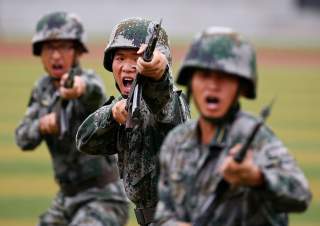Why Are Chinese Weapons Used so Frequently in the Middle East?
Cheap and plentiful.
Key point: Knock-off Chinese weapons are used in many battlefields.
The Syrian Civil War is being fought with firearms from around the globe. While American and Russian weapons are currently the most common, Chinese guns are rapidly increasing their “market share” of the battlefield.
While China has taken a notionally neutral position on the war, Chinese arms ending up in the hands of rebels, IS, and regime forces. How are they getting there? Do they hold any advantages over their Russian and American counterparts?
Probably the most common Chinese weapon in the Middle East is the Type 56 rifle, a variant of the ubiquitous AK. Characterized by the full ring surrounding the front sight, the Type 56 was exported in great numbers to the Middle East during the 1970s and 1980s, arming both Iran and Iraq during the Iran-Iraq wars. This has caused it to pop up everywhere in the region. It’s been seen in the hands of Iraqi insurgents and forms the bulk of the Islamic State’s arsenal. Type 56 rifles are also common sights within the Free Syrian Army and the Syrian regime National Defense Force.
Type 56 rifles on the battlefield could come from anywhere, with both old stock being widespread and Norinco still manufacturing the rifle for export. They are common on international arms markets and often bought up by nations looking to arm groups with some level of deniability.
The W85 heavy machine gun is a more interesting case. In previous wars in the region, most common heavy machine guns used by insurgents were of Soviet design. However, in the Syrian Civil War the Chinese W85 has reached prominence, showing up in many photos and videos from all sides.
The W85 is a modernized version of the Soviet DshK heavy machine gun, using a new front sight gas block and changing the receiver to reduce weight and improve simplicity. The similarity to the older machine gun means that crews trained on the older Dshk have an easy time utilizing the W85. The W85 is half the weight of the Dshk, making it far more mobile and faster to set up.
They are used primarily in the anti-aircraft role against Syrian regime aircraft. Many examples seen in pictures feature a wide angle anti-aircraft optical sight, possibly indicative of new-production W85s. It’s speculated that money used to procure these weapons came from Gulf states who support rebel forces. Interestingly, the W85 has also been seen on a small unmanned ground vehicle produced by an Iraqi militia.
Another surprisingly common weapon is the Norinco CQ, a Chinese copy of the American M16. These weapons have shown up on gun markets in the Middle East at significantly lower prices than original M16s and M4s, making them a good choice for a rebel who wants to look more “tactical” than his peers.
Where they are coming from is not certain. Iran is known to have purchased CQ rifles and produce it under license, but rifles similar to those seen in the Middle East have been seen and manufactured under license in Sudan.
The Norinco NP-20 pistol has also been widely seen on gun markets in the region Malhama Tactical, a notorious jihadi “PMC” has been filmed training with the pistol, which is said to be the most common 9 millimeter pistol in some areas of Iraq and Syria despite the proliferation of Glocks and Iraqi Tariqs.
Due to their resemblance to western pistols, NP-20s have often been stamped with western markings in an attempt to increase their value.
It’s not sure where the NP-20s are coming from, but they are likely new production smuggled in via proxies. The design only began production in 1989 and was not known to be in widespread use in any local military or police force prior to the conflict.
Other Chinese arms have seen use in the conflict in smaller numbers, primarily heavy weapons like the QLZ-87 automatic grenade launcher and M99 anti-material rifles. China’s neutral stance and large arms manufacturing capability have allowed it to produce arms for other parties to provide under deniable cover to their local proxies. In the future, more and more rebels around the world might be found armed with weapons all made in China.
Charlie Gao studied Political and Computer Science at Grinnell College and is a frequent commentator on defense and national security issues. Special thanks to Calibre Obscura for assistance on this article. This first appeared in Feburary 2019.
Image: Reuters.

